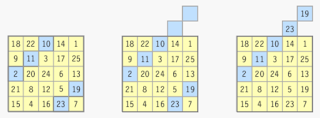Here is a definition of an ultramagic square:
A magic square is associative if the sum of any two elements symmetric about its center is the same. A magic square is pandiagonal if the sum of the numbers in any broken diagonal equals the magic constant. A magic square is ultramagic if it is associative and pandiagonal. Ultramagic squares exist for orders n>=5. Source.
Using this as a starting point, let's understand what is meant by a pandiagonal magic square. Here is a definition taken from a most useful website:
Pandiagonal magic squares are magic squares, where also the broken diagonals sum to the magic constant. This means when you go off of one edge on a diagonal, continue (wrap-around) to the corresponding cell on the opposite edge. These squares are considered as one of the top classes of magic squares.
Figures 1 and 2 show clearly what is meant by a "broken diagonal" and show a 5 x 5 magic square that is pandiagonal.
 |
Figure 1 |
 |
Figure 2 |
The magic square in Figures 1 and 2 however, is not associative. Using the central square (24) as a reference point, we note that, up-down 3 + 12 = 15 but left-right 20 + 6 = 26. These must be equal for a magic square to be associative. Figure 3 shows a 5 x 5 magic square that is both pandiagonal and associative, and thus ultramagic.
 |
| Figure 3 |
The magic constant for this square is 65 and it can be seen that all rows, columns, main diagonals and broken diagonals all add to this number. Furthermore, the up-down 6 + 20 = 26 and the left-right 2 + 24 = 26 are this time equal as are all the other symmetric pairs of elements.
Figure 3 shows a 7 x 7 ultramagic square:
 |
Figure 4: source |
Figures 5, 6 and 7 show 6 x 6, 7 x 7 and 8 x 8 prime ultramagic squares with magic constants of 990, 4613 and 2040 respectively:
 |
| Figure 5: source |
 |
| Figure 6: source |
 |
| Figure 8: source |
These magic constants (990, 4613 and 2040) are the lowest possible and form part of OEIS A257316:
A257316 | Smallest magic constant of ultramagic squares of order \(n\) composed of distinct prime numbers. |
The sequence runs 3505, 990, 4613, 2040 with 3505 being the magic constant (not shown) for the 5 x 5 ultramagic square with minimal magic constant. The following bounds for the next terms are known:
- 12249 <=a(9) <=13059
- 4200 <=a(10) <=46150
- a(11) >= 26521
- a(12) >= 8820
- a(13) >= 49439
- a(14) >= 16170
- a(15) >= 74595
- a(16) >= 21840
My attention was attracted to the topic because today I turned 26521 days old and this number happens to be the lower bound for the 11 x 11 prime ultramagic square with minimal magic constant. The exact composition of such a square is presumably still not known.
My earlier posts on Magic Squares are:
- Magic Squares on 21st September 2020
- Prime Semi-Magic Squares on 7th May 2021
- Anti-Magic Squares on 17th July 2018
No comments:
Post a Comment